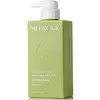What's inside
What's inside
 Key Ingredients
Key Ingredients

 Benefits
Benefits

 Concerns
Concerns

 Ingredients Side-by-side
Ingredients Side-by-side

Water
Skin ConditioningParaffinum Liquidum
EmollientGlycerin
HumectantBrassica Campestris Seed Oil
Skin ConditioningSodium Polyacrylate
AbsorbentPentylene Glycol
Skin ConditioningCetearyl Alcohol
Emollient1,2-Hexanediol
Skin ConditioningCaprylyl Glycol
EmollientAcrylates/C10-30 Alkyl Acrylate Crosspolymer
Emulsion StabilisingSodium Citrate
BufferingXylitol
HumectantCetearyl Glucoside
EmulsifyingMannitol
HumectantTocopherol
AntioxidantRhamnose
HumectantXylitylglucoside
HumectantHelianthus Annuus Seed Oil
EmollientAnhydroxylitol
HumectantNiacinamide
SmoothingGlucose
HumectantFructooligosaccharides
HumectantCaprylic/Capric Triglyceride
MaskingLaminaria Ochroleuca Extract
Skin ConditioningWater, Paraffinum Liquidum, Glycerin, Brassica Campestris Seed Oil, Sodium Polyacrylate, Pentylene Glycol, Cetearyl Alcohol, 1,2-Hexanediol, Caprylyl Glycol, Acrylates/C10-30 Alkyl Acrylate Crosspolymer, Sodium Citrate, Xylitol, Cetearyl Glucoside, Mannitol, Tocopherol, Rhamnose, Xylitylglucoside, Helianthus Annuus Seed Oil, Anhydroxylitol, Niacinamide, Glucose, Fructooligosaccharides, Caprylic/Capric Triglyceride, Laminaria Ochroleuca Extract
Water
Skin ConditioningCetyl Alcohol
EmollientGlycerin
HumectantDimethicone
EmollientButyrospermum Parkii Butter
Skin ConditioningCeteareth-20
CleansingCocos Nucifera Oil
MaskingHoney Extract
HumectantAloe Barbadensis Leaf Juice Powder
Skin ConditioningTocopheryl Acetate
AntioxidantCamellia Sinensis Leaf Extract
AntimicrobialPyrus Malus Fruit Extract
Skin ConditioningHelianthus Annuus Extract
EmollientOryza Sativa Bran Extract
Skin ConditioningRosmarinus Officinalis Leaf Extract
AntimicrobialTocopherol
AntioxidantCetearyl Ethylhexanoate
EmollientIsopropyl Myristate
EmollientCetearyl Phosphate
Skin ConditioningGlyceryl Stearate
EmollientSynthetic Beeswax
Emulsion StabilisingCarbomer
Emulsion StabilisingXanthan Gum
EmulsifyingTetrasodium Glutamate Diacetate
Parfum
MaskingPhenoxyethanol
PreservativeEthylhexylglycerin
Skin ConditioningCaprylyl Glycol
EmollientHexylene Glycol
EmulsifyingSodium Hydroxide
BufferingSodium Benzoate
MaskingWater, Cetyl Alcohol, Glycerin, Dimethicone, Butyrospermum Parkii Butter, Ceteareth-20, Cocos Nucifera Oil, Honey Extract, Aloe Barbadensis Leaf Juice Powder, Tocopheryl Acetate, Camellia Sinensis Leaf Extract, Pyrus Malus Fruit Extract, Helianthus Annuus Extract, Oryza Sativa Bran Extract, Rosmarinus Officinalis Leaf Extract, Tocopherol, Cetearyl Ethylhexanoate, Isopropyl Myristate, Cetearyl Phosphate, Glyceryl Stearate, Synthetic Beeswax, Carbomer, Xanthan Gum, Tetrasodium Glutamate Diacetate, Parfum, Phenoxyethanol, Ethylhexylglycerin, Caprylyl Glycol, Hexylene Glycol, Sodium Hydroxide, Sodium Benzoate
 Reviews
Reviews

Ingredients Explained
These ingredients are found in both products.
Ingredients higher up in an ingredient list are typically present in a larger amount.
Caprylyl Glycol is a humectant and emollient, meaning it attracts and preserves moisture.
It is a common ingredient in many products, especially those designed to hydrate skin. The primary benefits are retaining moisture, skin softening, and promoting a healthy skin barrier.
Though Caprylyl Glycol is an alcohol derived from fatty acids, it is not the kind that can dry out skin.
This ingredient is also used as a preservative to extend the life of products. It has slight antimicrobial properties.
Learn more about Caprylyl GlycolGlycerin is already naturally found in your skin. It helps moisturize and protect your skin.
A study from 2016 found glycerin to be more effective as a humectant than AHAs and hyaluronic acid.
As a humectant, it helps the skin stay hydrated by pulling moisture to your skin. The low molecular weight of glycerin allows it to pull moisture into the deeper layers of your skin.
Hydrated skin improves your skin barrier; Your skin barrier helps protect against irritants and bacteria.
Glycerin has also been found to have antimicrobial and antiviral properties. Due to these properties, glycerin is often used in wound and burn treatments.
In cosmetics, glycerin is usually derived from plants such as soybean or palm. However, it can also be sourced from animals, such as tallow or animal fat.
This ingredient is organic, colorless, odorless, and non-toxic.
Glycerin is the name for this ingredient in American English. British English uses Glycerol/Glycerine.
Learn more about GlycerinTocopherol (also known as Vitamin E) is a common antioxidant used to help protect the skin from free-radicals and strengthen the skin barrier. It's also fat soluble - this means our skin is great at absorbing it.
Vitamin E also helps keep your natural skin lipids healthy. Your lipid skin barrier naturally consists of lipids, ceramides, and fatty acids. Vitamin E offers extra protection for your skin’s lipid barrier, keeping your skin healthy and nourished.
Another benefit is a bit of UV protection. Vitamin E helps reduce the damage caused by UVB rays. (It should not replace your sunscreen). Combining it with Vitamin C can decrease sunburned cells and hyperpigmentation after UV exposure.
You might have noticed Vitamin E + C often paired together. This is because it is great at stabilizing Vitamin C. Using the two together helps increase the effectiveness of both ingredients.
There are often claims that Vitamin E can reduce/prevent scarring, but these claims haven't been confirmed by scientific research.
Learn more about TocopherolWater. It's the most common cosmetic ingredient of all. You'll usually see it at the top of ingredient lists, meaning that it makes up the largest part of the product.
So why is it so popular? Water most often acts as a solvent - this means that it helps dissolve other ingredients into the formulation.
You'll also recognize water as that liquid we all need to stay alive. If you see this, drink a glass of water. Stay hydrated!
Learn more about Water